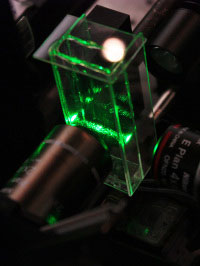| Dec 06, 2012 | |
A trampoline of light |
|
| (Nanowerk News) Guiding fluid droplets only by means of light is a vision which, although it seems to be taken from a science fiction film, has become reality through the field of research dealing with optical micromanipulation. Researchers from the Institute of Applied Physics at Münster University (WWU) have now succeeded for the first time in optically manipulating absorbing (in the sense of light energy-absorbing) micro-droplets in air, also known as aerosols. | |
 Experimental setup for the creation of a photophoretic trampoline; inside the glass cuvette, the laser light sheet was visualized by scattering particles. The renowned journal "Nature" presents these findings in its current issue under the heading "News&Views" ("Applied physics: An optical trampoline"). Earlier this month, "Nature Photonics" appreciated the results as a research highlight in the fields of photonics. original publication: "Photophoretic trampoline—Interaction of single airborne absorbing droplets with light" The team of researchers consisting of PhD students Michael Eßeling, Patrick Rose, Christina Alpmann, and the leader of the working group, Prof. Cornelia Denz, has been exploiting the effect of photophoresis. In this process a laser beam heats up one side of the micro-droplet. The heat thus generated is transferred back into the ambient air. "This air then expands and the pressure pushes the droplet away out of the laser beam", Michael Eßeling explains. In a first study published, the team had already been able to show that appropriate beam shaping techniques allow the preparation of a hollow three-dimensional "light bottle" in which absorbing particles can be trapped and controlled purely optically. In a second experiment the researchers have now shown that this effect can be transferred to aerosols containing micro-droplets. These aerosols occur whenever liquids are dispersed with a fine nozzle, such as is found in inkjet printers or spray cans. In their experiments the researchers use individual droplets from a specially prepared ink cartridge which fell onto a highly focused sheet of laser light. The micro-droplets are repelled by this light sheet as if by a trampoline. "This observation represents an important contribution to the field of optical manipulation of absorbing media," says Michael Eßeling. In future such droplets could be enclosed in a light trap, for example, to allow mixing processes to be observed or enable individual droplet components to be analyzed. |
| Source: University of Münster |
